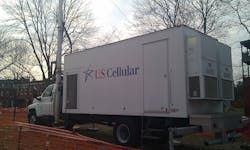U.S. Cellular provides a comprehensive range of wireless products and services and a high-quality network to customers with 4.9 million connections in 21 states. Their public safety priority service is available across our network, including rural and remote areas. Solutions over LTE and 5G networks are available with data priority and preemption services to first responders. I connected with Jim Anetsberger, Vice President of Sales for the business channel at U.S. Cellular.
Q. What does data speed mean to the officer on the street?
Our current 4G LTE upload and download speeds mean that an officer can easily access critical applications and communication tools over the data network. Solutions also include advanced cellular technology to keep mission critical equipment connected through the Internet of Things. And since there’s no way to predict how much data you’ll use in an emergency, we offer customized public safety plans that allow unlimited and unthrottled data usage for phones and all other devices.
As we updated our infrastructure to build out our 5G network, we also increased the speeds on our 4G LTE network (sometimes referred to as LTE Advanced). And on our 5G network, customers on average experience double the speed we see on our 4G LTE network. As we move forward with our deployment of 5G we anticipate our speeds will continue to increase.
Q. Does the network separate the voice vs data?
Yes. There are times when network crowding can make voice calls difficult, so Wireless Priority Service queues mission-critical calls first.
Our public safety solution also provides emergency responders a dedicated broadband network that separates mission-critical data from commercial and consumer traffic. The network is designed to provide first responders, law enforcement and critical support teams with consistent high-quality service, priority on the network and preemption over non-essential data whenever it is needed, because we know effective communication also includes video, text, e-mail, phone and geographical data.
Q. How is the network designed to handle high traffic?
We’ve designed a highly reliable, hardened network that can withstand shifts in bandwidth needs and manage expected and unexpected increases in usage. We know there are times when demand increases, so we built in extra capacity to act as a shock absorber, so if demand goes higher than expected, it can be absorbed by the system.
We also use a variety of artificial intelligence-based systems to self-manage the network. These systems automatically optimize and self-heal the network as conditions change.
Q. How is the network designed to handle unforeseen circumstances like power outages, or natural disasters?
We have a full disaster recovery program with associates ready to execute in a time of emergency. We also design our cell sites with battery backup, generators and equipment redundancies within the facilities to help ensure continuous service even when there are power outages. These generators and battery backups are regularly tested and fueled and ready to kick in on a moment’s notice.
In the event of damage to a cell site caused by a natural disaster, we have Cell On Light Trucks that can provide on-the-spot cellular connectivity. They are equipped with a self-contained power supply and can be deployed within 24 hours to any part of our footprint.
We’ve learned from various natural disasters over the years, and with AI, we integrated several systems that optimize the network and have specific functionalities that optimize during natural disasters or times of increased usage. For example, one of them adds and moves capacity and signals around the network to where the people are, while another AI platform focuses on security and monitors for malicious traffic or hacking attempts to prevent them from getting to customers.
Q. Has law enforcement/public safety technologies adapted to use 5G?
Earlier this year, we introduced 5G technology to customers in both urban and rural communities in Iowa and Wisconsin. This initial 5G deployment is on our 600 MHz spectrum and placed on macro towers higher up to increase broad coverage of the 5G signal—improving the coverage in rural communities. We expect to augment our network with mid and high-band spectrum over time as the technology and use cases continue to evolve.
We currently have two 5G smartphones available for consumers, businesses, and our public safety/government customers, and the full benefit of the network will be available when more 5G-specific devices are commercially available.
The enhancements that 5G can bring to public safety are vast, and we are working towards bringing new capabilities to our public safety customers. For example, officials will have the ability to transfer field interviews, building blueprints and on-site video at near-real-time speeds. And with 5G’s low latency, high-definition surveillance video can be transferred with little to no lag time.
Q. What’s on the horizon?
We are on a multi-year journey to rapidly move across our footprint to bring 5G to as many of our customers as possible over the coming years. One of the things I’m most excited about with 5G is the opportunity for more smart cities. 5G will serve as the foundation for small cell networks that will power wireless network infrastructure in smart cities, and public safety will see several benefits from this technology. We’ve been working side by side with some local governments in our markets and helping lay the groundwork for these communities to develop and achieve their smart city goals with us.

Jonathan Kozlowski
Jonathan Kozlowski was with Officer.com, Law Enforcement Technology, and Law Enforcement Product News from August 2006 to 2020.
As former Managing Editor for Officer Media Group, he brought a dedicated focus to the production of the print publications and management of the Officer.com online product and company directory. You can connect with Jonathan through LinkedIn.
Jonathan participated as a judge for the 2019 and 2020 FOLIO: Eddie & Ozzie Awards. In 2012, he received an APEX Award of Excellence in the Technology & Science Writing category for his article on unmanned aerial vehicles (UAVs) in police work, aptly titled "No Runway Needed".




